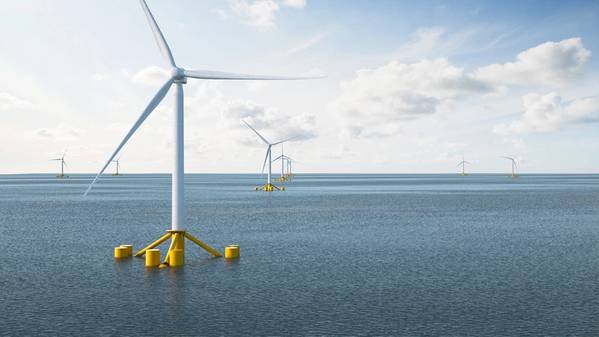
The Copenhagen Infrastructure Partners-led Pentland Floating Offshore Wind Farm project in Scotland has submitted an application to vary its Section 36 consent and associated marine licenses as a result of further survey work and advancements in project design.
The S36 Consent and associated marine licenses were granted by the Scottish Government Marine Directorate for the 100MW floating wind farm project earlier this year.
The company said the variations would refine the project’s design parameters, enabling the wind farm to reduce the number of turbines deployed and the geographical extent of the array while maintaining total capacity.
In its statement on Thursday, the company initially did not say exactly how many turbines it planned to install.
A July 2022 document on the company's website says "the maximum number of turbines being applied for has been reduced from ten down to seven, which will further reduce the potential visual impacts." This would call for ~14 MW turbines.
Offshore Engineer has reached out to the company, seeking clarification.
"The number of turbines has now been reduced from 7 to 6. Advancements in turbine technology and design refinements as the project has progressed means the same capacity can be achieved with fewer turbines than initially planned for," the company spokesperson replied.
Taking into account that the planned wind farm capacity is 100 MW, these six turbines would need to have ~16.6 MW capacity each. For reference, these would be more powerful than those currently being installed at the world's largest offshore wind farm project - Dogger Bank - with of +13MW and 14MW capacity - the largest ever installed so far in European waters.
Given that major offshore wind turbine suppliers to Europe, such as GE, Siemens Gamesa, and Vestas, don't have 16MW+ turbines on offer yet, Offshore Engineer has reached out again to the company, seeking more info on the planned turbine installation plans and for confirmation that the wind farm is still planned to have 100MW capacity.
"It is still planned that the project will have a 100 MW capacity and we expect that sufficient capacity WTGs will be available in the project delivery timescales," the spokesperson said.
Worth noting, China Three Gorges Corporation installed the world's first 16 MW offshore wind turbine in June off the coast of Fujian, China.
Future-proofing the site
Commenting on the application to revise the S36 consent. Richard Copeland, Project Director, said: "The project reached the significant milestone of achieving offshore consents earlier this year. Now, as a result of further design and survey work, we have proposed refinements to the consent to reflect the most accurate design parameters. This submission is a result of a significant effort to build a robust project which prioritizes sustainability, remains considerate of the natural environment, and reflects the views of local communities and stakeholders.
“The variations will future-proof the site, ensuring we can deliver greater benefit to the local community and Scotland’s energy sector as a whole.”
The application follows the submission of a screening request by Highland Wind Limited in August and a screening opinion from the Marine Directorate in September.
The development, which is situated 7.5km off the coast of Caithness, is anticipated to produce enough green electricity to power 70,000 households - 65% of those in the Highland Council area.
The Pentland Floating Offshore Wind Farm is planned to be operational in 2026.
The floating wind farm will be developed using Stiesdal Offshore’s TetraSub floating structure technology, which has been described as the world’s first fully industrialized floating offshore technology, offering a cost-effective floating foundation made up of factory-made modules.
The process is said to significantly reduces manufacturing hours and enables assembly to take place domestically within local ports, maximising the opportunity to local supply chains and communities.
The project is being developed by Highland Wind Limited which is majority owned by Copenhagen Infrastructure Partners (CIP) through one of its CI Funds with Hexicon A/B as a minority shareholder.



